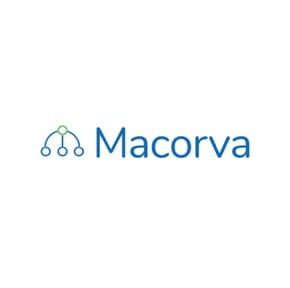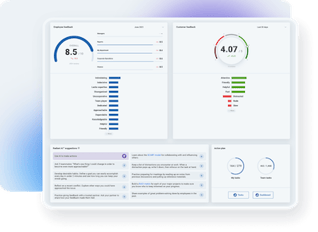
Employee Experience vs. Engagement: Essential Guide for 2025
Corporate Wellness Magazine agrees, saying nothing is more critical to employee retention than company members who feel their employer supports their efforts and values them as a human resource. Employees develop extraordinary loyalty to stakeholders who create a distinctive job description the candidate can leverage with a sense of purpose.
It's no wonder enlightened strategists want to know about employee well-being and how their staff feel about their work environment. They go the extra mile to create a company culture that delivers worker contentment, balance, and cooperation. However, despite one's best intentions, workplace dynamics sometimes create situations where people get frustrated, impatient, volatile, or angry—more disruptive than harmonious—creating employee disengagement (where the wheels come off the bus).

The key to a productive workforce and organizational success revolves around analyzing Employee Experience (EX) vs Employee Engagement (EE). Here's the thing: Many stakeholders use the terms interchangeably, thinking they’re the same thing. Yet, although related, they’re subtly different, and solid strategic planning depends on knowing the difference. It involves asking questions, such as:
- Is a fulfilling employee experience possible without employee engagement?
- Is it likely an engaged employee will complain about a demotivating EX?
- Put another way, can the two survive independently of one another?
If this resonates with you and you want the answers to these questions, read on.

What is Employee Experience?
Employee experience defines an employee’s predominant feelings and thoughts about an organization after connecting with all its cultural, environmental, and technological touchpoints through learning, seeing, and doing. It’s often referred to as an Employee Journey. Why? It begins with the employee's first company connection (e.g., applying for a pre-hire interview). From there, it progresses - perhaps through a series of interviews before getting a job offer - then step-by-step through the onboarding phase to becoming fully team-integrated. That's not the end of the employee journey. Indeed, it may be only the beginning of years working on many projects, continuing until termination (voluntary or otherwise) and into the post-exit phase.
Employee journeys are not smooth, continuous processes. There are stops and starts - stepping stones if you will. For example, employees interact with new job challenges, connect with other team members, do desk work, make presentations, attend lectures, listen to podcasts, meet customers, go to company happy hours, and manage family matters in between (just a few of possibly thousands of zigzagging connections weekly and monthly). These dynamic events are what we call touchpoints. So, our overview of the employees moving from one touchpoint to the next - in essence, the employee journey - defines EX.
The takeaway from the above is that the EX pace, routes, and touchpoint characteristics depend substantially on the company culture, strategies, and opportunities to advance. In short, these are planning activities controlled and applied at the C-suite level.
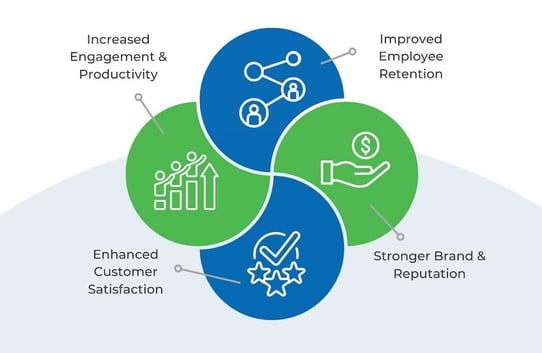
To demonstrate, visualize Company X with a supportive work environment that encourages:
- Team synergy
- Employee feedback
- Transparent communications
- A structured onboarding program
- Supervisory assistance willingly provided
- Relevant on-the-job training
- Promotion from within
- Recognizing employee achievements
- Sharing growth and profitability rewards with employees
- Regular employee well-being checks and surveys
- A flexible work framework
Now imagine Company Y bypassing some or many items listed above. The touchpoint structure and the employee experience emerging would look entirely different, and employee well-being (happiness) undoubtedly would move on different trajectories.
In reality, many businesses can point to EXs that are exemplary for some employees (and not others) or all employees in stops and starts - with ups and downs. However, that’s far from enough for organizational success. What counts is EX consistency—maintaining a stellar standard throughout the workplace across all the touchpoints, with the resilience to cover entire employee lifecycles.
What is Employee Engagement?
Employee engagement defines how emotionally driven and cognitively aligned an employee is to achieve company goals when participating individually and with teams in activities after reaching a crucial touchpoint. The conversation around employee experience vs engagement isn’t straightforward. Why? Whereas it’s crucial to appraise EX across a string of touchpoints over time (see above), EE relates more to a focused touchpoint (or cluster of them close together). In other words, the EE is more relevant at a moment in time than over time.
The crux of the matter is knowing today how emotionally attached employees are to the company, their level of enthusiasm, and their motivation to deliver superior results. That's irrespective of how they arrived at the current stop in the employee journey or whether the EX has been happy so far.
Of course, many strategists naturally conclude that a positive EX guarantees a positive EE whenever you decide to look at it, but that's not always true. Why? Unfortunately, it takes only one disruptive touchpoint - a distasteful event - to disintegrate or diminish the memory of previous ones. In other words, it boils down to knowing if one's employees are currently vesting their energies in work challenges or if they are distracted, and if so, in what way?

Robust employee engagement revolves around employees who:
- Stay focused, going the extra mile to deliver results better than the company expects.
- Cooperate with peers and team participants to coordinate efforts and reach goals faster and more efficiently.
- Eagerly grab any job training opportunities available.
- Take pride in their work.
- Enjoy the recognition and respect it as being sincere.
- Integrate seamlessly with the company culture.
- Transfer their enthusiasm when making customer contact.
- Demonstrate emotionally balanced interactions.
- Regard organizational success as their own.
On the other hand, unengaged employees express opposite behavior traits. They scan the 'for hire' columns (looking to jump ship) and disrupt project harmony. Some are openly sullen and unfriendly, late on deadlines, prone to unexpected outbursts, etc. Even employees blessed with a consistent EX have interludes of disengagement when something upsets or frustrates them. In short, EE is all about employees' state of mind and feelings at the time point you look at their performance.
How do Employee Experience and Employee Engagement align with one another and contribute to organizational success?
Any stakeholder who believes their company delivers a five-star EX yet encounters employee disengagement (and the inevitable disruption) should reexamine their optimism. With a 20/20 vision, employee experience must achieve acceptable EE at every vital touchpoint, drawing the necessary momentum to move to the next one. However, practically, the only EE insight that matters is the one that applies today (i.e., to current EX touchpoint situations). Past employee engagement is excellent, but it’s no remedy or compensation for employees disengaged in real time.
EX planners cannot ignore how the staff feel about every aspect of the workplace. Again, why? Feelings are the drivers of employee engagement. What does that imply?
- Stakeholders must create consistency in their EX strategies to ensure employee engagement is baked into the process no matter what development phase employees are in or which touchpoints they're dealing with.
- Therefore, EX structuring is the means to creating a superior EE, which is the objective at every juncture within the employee journey.
- So, adopting an EX/EE integrated approach is the key to unsurpassed employee retention.
The items listed above point to organizational culture and leadership as common ingredients in the EE and EX recipes. Alternatively, a corrupt culture and short-sighted managers will derail both. Also, let's be clear: EX is not interchangeable with employee engagement. You get the latter from achieving a smooth and memorable EX for all the right reasons.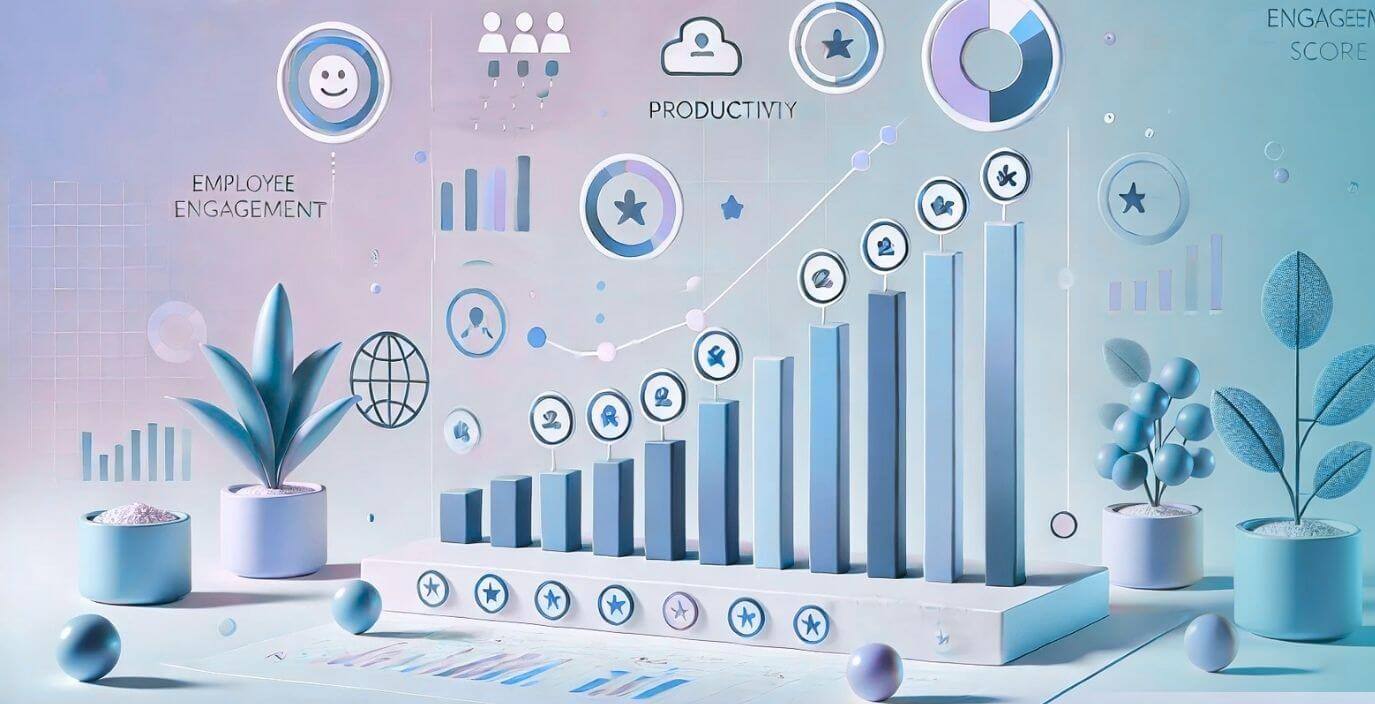
10 Strategy Tips for Enhancing Employee Experience and Engagement
The logic above underlines that EX revolves around the company's input, aimed at attracting responsive employees (the essence of EE) who will find the culture fits their lifestyle. If predicted accurately and applied with forethought, employee engagement is inevitable. So, in this respect, the strategy inclusions itemized below are EX- and EE-centric, aligning with the improvement of both simultaneously or in sequence. They include innovative moves for 2025 and beyond, such as:
1. Hybrid and remote workplace options - priority policy considerations to help employees achieve the ideal work/family time balance.
2. Supporting Physical and Mental Health: This aligns seamlessly with offering flexible work environments, involving initiatives that promote employees' overall well-being by providing wellness programs and mental health resources.
3. A top-down approach by involving managers, making them the first in line for an improved EX and EE. Why?
- Leaders must embrace the organization's values and mission before EX and employee journey initiatives can gain traction. Unless they’re in boots and all, strategic initiatives will likely fail.
- It’s the most rewarding route to creating motivated leadership committed to developing enriched touchpoints for all employees.
- Engaged managers - focused, specialized, and trained - are the key to an engaged workforce.
4. Advanced and virtual technologies play a vital role in removing mundane tasks from EX and replacing them with jobs that require creativity and intelligence. For example, AI and ML-driven tools have the power to:
- Extend the employee lifecycle, especially for Millennial and Gen Z staff members who adjust to cutting-edge software like ducks to water.
- Improve operations and run better processes, which are significant contributors to bolstering employee retention.
AI adoption in performance management exploded in 2024 and will continue to impact HR strategies in 2025. AI-assisted performance management offers managers real-time visibility over employee development plans, admin tasks, and analytics workflows. Modern AI can reduce the burden on HR resources while enhancing performance management with unbiased performance tracking and actionable insights into individual employee performance.
5. Employee advancement programs: Build these around a resource pool of virtually accessible videos, podcasts, case studies, team retreats, formal training sessions, and work flexibility. This inevitably leads to and merges with career development opportunities and paths for growth within the organization.
6. Generating employee feedback to assess EX satisfaction and EE ratings at every touchpoint from the onboarding phase onwards. In this regard:
- It’s no good just gathering employee feedback. A healthy corporate culture vested in organizational success acts on it, capitalizing on insight values the surveys deliver.
- Macorva’s advanced employee listening software steps into the employee experience vs employee engagement picture with everything you need to measure your business’s workforce productivity and emotional temperature (see more below). By utilizing advanced AI feedback analytics, managers can achieve measurable results by uncovering hidden data trends and contextualizing their insights through AI-powered industry analysis and personalized employee performance assessments.
7. Establishing key performance indicators (KPIs) as yardsticks for stakeholders and employees at every crucial touchpoint.
- These measure performance and how it’s impacting ROI (the bottom line).
- Negative deviations from expected KPI standards are the first signs of EX and EE derailing.
8. Recognize and reward employees: Employees who exceed KPI expectations are engaged employees. However, don't take them for granted - follow up with meaningful rewards that cover anything from free gifts to profit sharing and promotion. Again, this emphasizes that some tactics (e.g., KPI and feedback focus) merge into others - innovative add-ons that consolidate gained advantages.
9. Streamlining Internal Communications: Using technology (described above) and thinking out of the box, establish clear, consistent, and transparent communication channels. Nothing generates frustration and distress (i.e., anti-EE dynamics) more than:
- Workplace rumor-spreading - a consequence of “closed door” policies.
- Work groups creating unauthorized power pockets that threaten peer harmony.
- Obstructions to venting or expressing feelings/ideas without the threat of irrational boss or peer reaction.
10. Community Involvement: Engaged employees love participating in community-focused programs and knowing the company culture values such efforts in their EX strategies.
Crucial EX and EE statistics
According to Gallup, only 23% of employees worldwide are acceptably engaged in their employers' value proposition, although much of this hides behind passive-aggressive behavior patterns. Its study shows that since 2009, the number of employees “extremely satisfied” with their company as a place of work has decreased from 30% to 18% in Q4 2024. Further, it reflected that severely lacking EX-connected strategies (such as culture, pay/benefits, and well-being resources) put companies at greater risk for low engagement.
In contrast, organizations adopting best practices for engagement have seen their rates increase to 70%.
Further studies conducted by Spencer Stuart found that a consistent EX with EE qualities baked into crucial touchpoints resulted in a 100% financial performance improvement. The research further indicates that:
- When EX is inconsistent it only achieves 17% EE/employee retention success. On the other hand, strong consistency results in a reading of 91% for the same metric.
- On this same EX consistency spectrum ("inconsistent" to "strongly consistent”), other offshoots of the analysis are as follows:
- Employee intent on prolonging employment: 43% to 89%.
- Company ROI performance (above the average): 32% to 65%.
- Customer Engagement (above the average): 30% to 69%.
Point (b) above, in particular, indicates how powerfully EE drives customer loyalty. In short, consumers quickly sense indifferent client service, which has a massive influence on customer churn.
Examples of employee experience that result in extraordinary employee engagement
The Employee Experience vs Employee Engagement benefits resonate across the industrial landscape. Here are three good examples:
Macorva empowers businesses to elevate their employee experience and engagement through the innovative use of AI and machine learning technologies. Here's how our platform stands out in enhancing EX and driving exceptional employee engagement:
- With advanced analytics, we turn feedback into actionable strategies, addressing key employee needs to boost engagement.
- Our AI-driven approach offers comprehensive performance evaluations quickly, using KPIs for a full-picture view that enhances the work environment.
- Insights from Macorva aren't just data—they're the basis for initiatives that significantly improve employee satisfaction and engagement.
DoorDash: A San Francisco food delivery platform relies on a flexible workplace model vested in the hybrid system, with fully remote work always considered.
Monday.com: A company where EX revolves around full transparency, unambiguous communication protocols, flexible work methods, and a comprehensive physical, mental, and emotional well-being resource pool.
Conclusion
So there you have it: Although EX and EE are different, the interconnectedness is as clear as day. Staff engagement and retention is a fantasy without a consistently vibrant employee experience strategy.
Conversely, management can trace lapses in EE back to defective touchpoints in the employee journey. So, grasp the fundamentals around both concepts holistically to create a workplace where employees are willing and excited to contribute their best work. It's the key to your organizational success. With this in mind, leveraging technology like Macorva's robust EX features empowers your employee experience and engagement strategies in 2025 and beyond.
Interested in transforming your workplace? Discover how Macorva can support your goals moving forward. Learn more about Macorva EX.
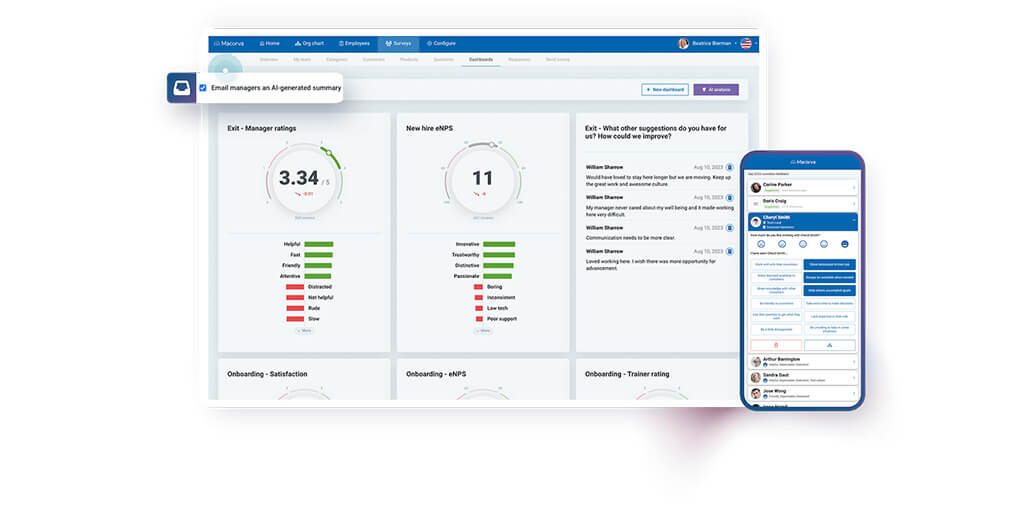
Additional resources to explore:
Blog - The future of the employee experience - navigating the shifting landscape
Case study - Streamlining employee surveys at Mass Medical
Ebook - Improving employee engagement for better business outcomes
Editors note: this blog was originally published in March 2024 and has been updated for accuracy and comprehensiveness.
